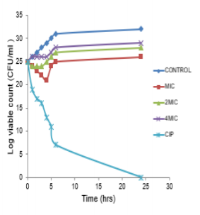Antimicrobial and time-kill kinetics of the aqueous extract of Citrullus lanatus (Thunb.) seeds
Main Article Content
Abstract
This study evaluated the antimicrobial property of the aqueous extract of Citrullus lanatus (watermelon) seeds and its concentration-effect relationship (time-kill studies) on typed bacterial and fungal strains. Crude powdered seeds of Citrullus lanatus were extracted by maceration with water. Antimicrobial assay of the aqueous extracts was determined against Bacillus subtilis (NCTC 8236), Escherichia coli (ATCC 25922), Pseudomonas aeruginosa (ATCC 10145), Staphylococcus aureus (ATCC 25923), and Candida albicans (ATCC 24433) using standard microbiological methods. A total of 106 CFU/mL of each test strain was used as a baseline to carry out the time-kill studies. Extract concentration at minimum inhibitory concentration (MIC), 2MIC and 4MIC were used over a period of 24 hours. Aqueous extract had an intermediate antibacterial activity with inhibition zone diameters (IZD) of 15 - 18 mm and MIC range of 2.5 - 20 mg/mL. Time-kill studies showed a bacteriostatic, nonconcentration dependent mode of antimicrobial activity with characteristic regrowth for all test strains. Citrullus lanatus seeds aqueous extract exhibited antimicrobial activity with a bacteriostatic, nonconcentration dependent mode of action against test bacterial strains. Further studies aimed at isolating and purifying the antimicrobial principle in the aqueous extract of C. lanatus seed is warranted as this could serve as a potential new antibiotic for treating microbial infections.
Downloads
Article Details

This work is licensed under a Creative Commons Attribution-NonCommercial-NoDerivatives 4.0 International License.
References
Adedeji, T.O. (2018). Extraction and evaluationof oil from watermelon (Citrulluslanatus) seed. Journal of NutritionalHealth and Food Engineering. 8(4):293-295.
Afolayan, A.J. and Meyer, J.M. (1997). The antimicrobial activity of 3,5,7-trihydroxyflavone isolated from the shoots of Helichrysum aureonitens.
Journal of Ethnopharmacology. 57: 177-181.
Babaiwa, U.F., Erharuyi, O., Falodun, A. and Akerele, J.O. (2017). Phytochemical and anti-oxidant properties of Citrullus lanatus seeds extracts. Nigerian Journal of Pharmaceutical Sciences. 16(2): 55-60.
Braide, W., Odiong, J. and Oranusi, S. (2012). Phytochemical and antibacterial properties of the seeds of watermelon (Citrullus lanatus). Prime Journal of Microbiology Research. 2(3): 99-104.
Clinical and Laboratory Standards Institute (2015). Methods for Dilution Antimicrobial Susceptibility Tests for Bacteria That Grow Aerobically;
Approved Standard - Tenth Edition. CLSI document M07-A10. Clinical and Laboratory Standards Institute,
Wayne, Pennsylvania, USA. Drusano, G.L., Neely, M., Van Guilder, M., Schumitzky, A., Brown, D., Fikes, S., Peloquin, C., Louie, A. (2014) Analysis
of combination drug therapy to develop regimens with shortened duration of treatment for tuberculosis. PLoS One. 9(7): e101311.
Egbuonu, A.C.C. (2015). Comparative assessment of some mineral, amino acid and vitamin compositions of watermelon (Citrullus lanatus) rind and seed. Asian Journal of Biochemistry. 10: 230-236.
Englehardt, J.D. and Chiu, W.A. (2019). A general dose-response relationship for chronic chemical and other health stressors and mixtures based on an emergent illness severity model. PLoS One. 14(2): e0211780.
Erhirhie, E.O. and Ekene, N.E. (2013). Medicinal values on Citrullus lanatus (Watermelon): Pharmacological review. International Journal of Research in Pharmaceutical and Biomedical Sciences. 4(4):1305-1312.
Foster, D.M., Jacob, M.E., Warren, C.D. and Papich, M.G. (2016). Pharmacokinetics of enrofloxacin and ceftiofur in plasma, interstitial fluid,
and gastrointestinal tract of calves after subcutaneous injection, and bactericidal impacts on representative enteric bacteria. Journal of Veterinary Pharmacology and Therapeutics. 39: 62-71.
Hassan, L.A., Hasnah, M.S., Sakina, M.A., Waleed, S.K. and Abdelwahab S.I. (2011). In vitro antimicrobial activities of chloroformic, hexane and ethanolic extracts of Citrullus lanatus var. Citroides (wild melon). Journal of Medicinal Plant Research. 5(8): 1338- 1344.
Keepers, T.R., Gomez, M., Cleric, C., Nichols, W.W. and Krause, K.M. (2014). Bactericidal activity, absence of serum effect and time kill kinetics of ceftazidium-avibactam against beta lactam producing enterobacteriacea and Pseudomonas aeruginosa. Antimicrobial Agents Chemotherapy.
(9): 5297-5305.
Konaté, K., Mavoungou, J.F., Lepengué, A.N., Aworet-Samseny, R.R., Hilou, A., Souza, A., Dicko, M.H. and M'batchi, B. (2012). Antibacterial activity against β-lactam producing methicillin and ampicillin resistant Staphylococcus aureus; fractional inhibitory concentration index (FIC)
determination. Annals of Clinical Microbiology and Antimicrobials. 11: 18.
Li, J., Xie, S., Ahmed, S., Wang, F., Gu, Y., Zhang, C., Chai, X., Wu, Y., Cai, J. and Cheng, G. (2017). Antimicrobial activity and resistance: Influencing
factors. Frontiers in Pharmacology. 8: 364.
Maoto, M.M., Beswa, D. and Jideani, A.I.O. (2019). Watermelon as a potential fruit snack. International Journal of Food Properties. 22(1): 355-370.
Moore, H. (2018). How to mathematically optimize drug regimens using optimalcontrol. Journal of Pharmacokinetics and Pharmacodynamics. 45(1): 127- 137.
Murray, P.R., Baron, E.J., Pfaller, M.A., Tenover, F.C. and Yolken, R.H.(1999). Manual of Clinical Microbiology. 7th ed. ASM Press, Washington, DC, pp 234- 239.
Okoli, S. and Iroegbu, C.U. (2005). In vitro antibacterial activity of Synclisa scabrida whole root extract. African Journal of Biotechnology. 4(9): 946-
Pohl, A., Lübke-Becker, A. and Heuwieser, W. (2018). Minimum inhibitory concentrations of frequently used antibiotics against Escherichia coli and Trueperella pyogenes isolated from uteri of postpartum dairy cows. Journal of Dairy Science. 101(2): 1355-1364.
Shao, X., Mugler, A., Kim, J., Jeong, H.J., Levin, B.R. and Nemenman, I. (2017). Growth of bacteria in 3-d colonies. PLoS Computational Biology. 13(7): e1005679.
Tonoyan, L., Fleming, G.T.A., Mc Cay, P.H., Friel, R. and O'Flaherty, V. (2017). Antibacterial potential of an antimicrobial agent inspired by
peroxidase-catalyzed systems. Frontiers in Microbiology. 8: 680.


